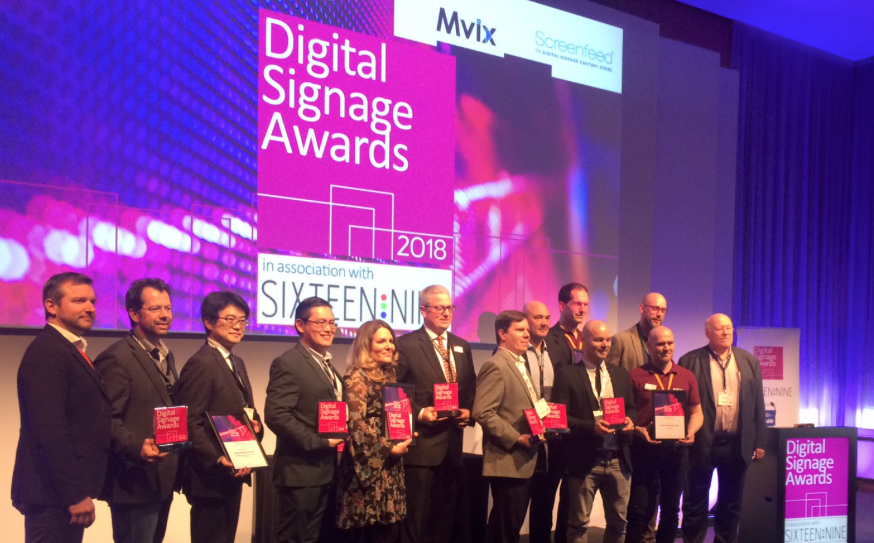
If You’re Entering Awards, Treat Your Work, And Submission, Seriously
October 25, 2019 by Dave Haynes
Guest Post: Bryan Crotaz, Silver Curve

I’ve been on the jury of five European digital signage awards over the past 10 years, and I’ve seen the same simple mistake over and over again. I’ll let you into the judging room secrets here if Dave will allow me to divulge.
The rules for the jury are simple. To avoid any suggestion of bias, you have to justify your votes on the basis solely of what the entrant has provided. Doesn’t matter how well you know the entrant, that your children go to school together, that they always produce amazing work, it’s all down to the quality of the entry.
Add to that that points, especially in the shortlisting stages, are split by different topics. These topics vary by the award, but generally they’re communicated to the entrants. When I’m judging, I get sent a huge zip file of all the entries – it can take 2 days to properly read through them all. So when I’m looking at the last one, I need to prove to myself that my criteria haven’t changed since the first one. So I set up a spreadsheet with my own subtopics in it, generally scoring 1-5 each, and I do this before I read any of the entries.
So every question I ask in my head about your project had better be answered by your entry, otherwise I will have to score zero for it.
Many is the time that I’ve shown one of your videos or photos to a family member, really frustrated that it looks amazing, and I bet you’ve made it secure, but you haven’t told me how. Or that the still and text you’ve provided on a content project hints at amazing animation but there’s no video clip. Or you’ve told me that you got great responses from the client, but there are no named quotes. Find the best medium to show what you did and show it off. We want to be shown off to – we love seeing great projects!
Those are projects that should win awards, but in at least one case didn’t even make the shortlist, purely because the information wasn’t there.
Put yourself in the mind of the jury. They tend to have different specialisms – I’ve judged with architects, journalists, designers, marketeers and we all come at it from a different direction. Think about what questions we might be asking, and answer them in your entry.
Don’t just give us the marketing video about the entire project if you’ve just done the signage – there’s 10 minutes of the Managing Director saying how amazing the carpets are (ok, I exaggerate) and in the distance in the back of the shot we have to evaluate your work.
Make a shorter video showing just your work and your client talking about it. Insert some of your content directly into the video – don’t shoot it on a screen and fight with reflections. If it’s interactive, show a full user journey in a single shot and how tight and simple you’ve made it.
Show your project in its best light. Especially in multinational awards, try to provide your entry in multiple languages – maybe ask about the nationalities of the jury. I’ve judged a German awards where I had to use Google Translate to read your entry in English (sorry, I’m one of those awful Brits who has basic schoolboy French and nothing else).
Now I’m very sure that Google Translate does not do a good job on the technical details of your project. Reading between the lines doesn’t get me very far. I’m sure your translator will do a much better job. If you have a video, it possibly has a foreign client talking – provide English subtitles which most Europeans will be able to read, or the equivalent common language on other continents.
Often there is a word limit on your entry. But there’s nothing to stop you inserting diagrams and drawings to better explain yourself.
When I judge, I’m not just asking “Are the graphics pretty?”
I’m asking:
– Did it do what the client wanted?
– Have you used the most appropriate technology?
– How did you save the client money?
– Would it scale? (if appropriate)
– Is it secure? How?
– Is it usable?
– Is it informative/entertaining/etc? Was it supposed to be?
– Is it maintainable?
– Is it robust / resilient? Does it need to be?
– and many many more…
Each specialist jury member will be asking their own questions. Get inside our heads and think about what we want to know. Spending 5 paragraphs telling us the size and turnover of your client doesn’t answer our questions.
Several of the awards I’ve judged have a special award – a sort of “best in show”. This is the fun part as a jury member. We often get to sit around a table with your entry packs in front of us, arguing the case for our favourites for literally hours. Often my mind has been changed by a needlesharp point from another jury member referring back to yet another play of your entry video. But often we shortlist down to a couple of entries with a very simple filter – eliminating those projects who didn’t explain how their project met the client’s brief, and getting some sort of measurement afterwards to show that it did. Start with that, and go from there, and you’ll get much better results from your tiny entry fee.
Finally, pick the right category. Often there are several that might fit. Think about the best parts of your project – what’s really special? Find the category that fits that feature, otherwise you’ll be beaten by projects which just fit better
Good luck in the awards of your choice and maybe I’ll be handing you a trophy in the near future!



Leave a comment